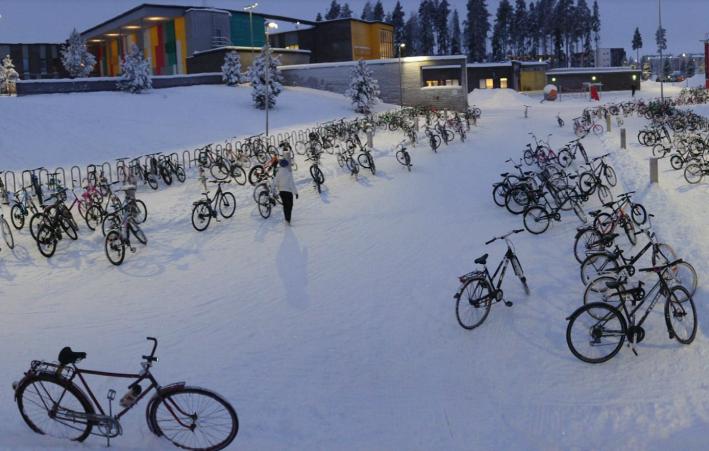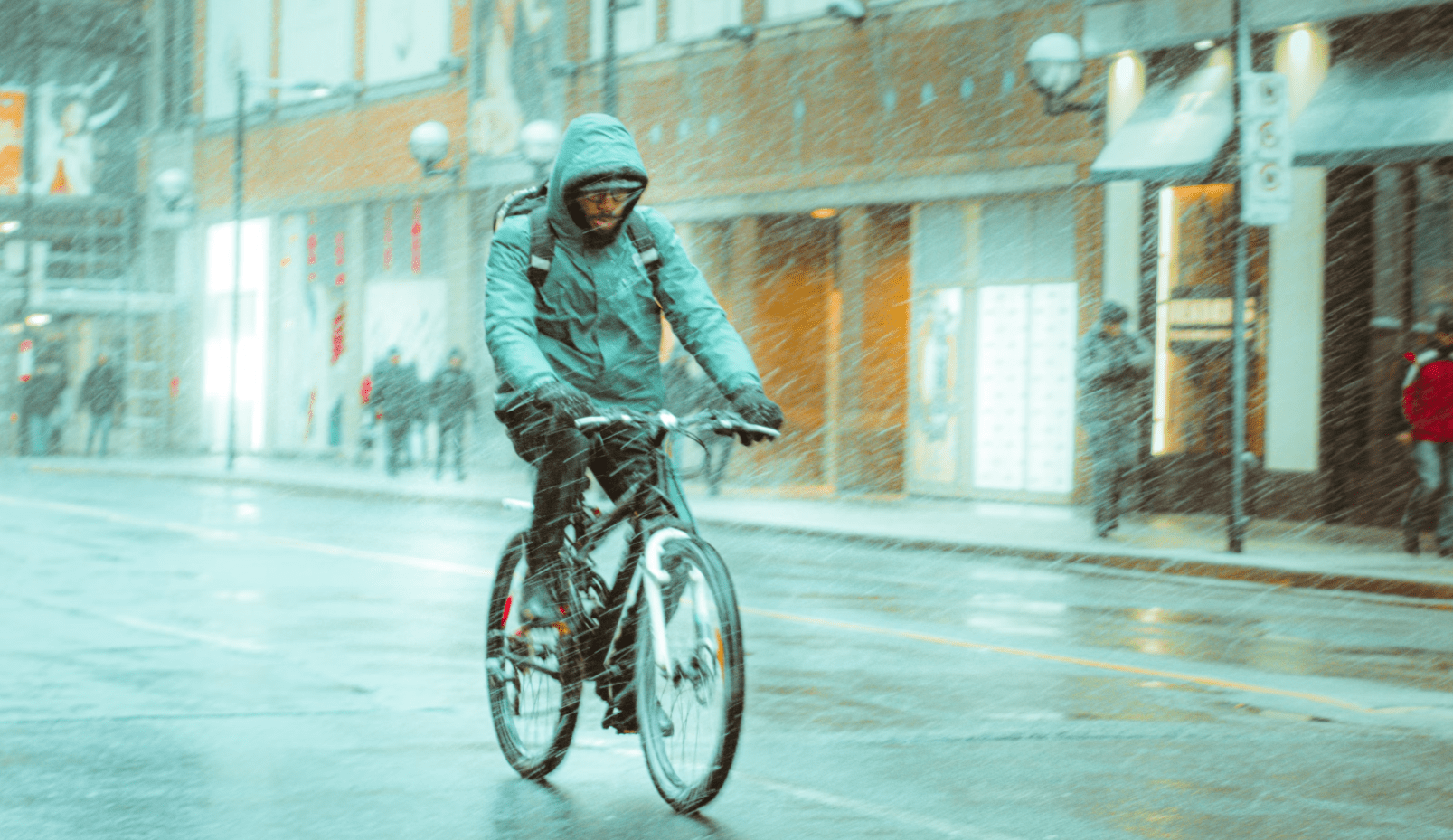During a panel discussion I participated in the other day, a member of the audience asked a version of question I get all the time: Why should we support active transportation if no one bikes in bad weather? I live in the Pacific Northwest, and the bike lane's always empty when it rains — how is that "essential infrastructure"?
I gave some variation on my usual two-minute answer — a lot of people do bike in the rain, even if they do so less, and we can do a lot more through policy and culture to increase those numbers. But there's more to that answer.
The truth is, the relationship between sustainable transportation and inclement weather is complex, and it's becoming a bigger issue by the day as climate change sends temperatures skyrocketing and storms of all sorts raging through our communities. And despite their outsized role in creating those disturbing weather patterns, cars are broadly seen as a common-sense way to escape the elements — while biking, walking, rolling, and even simply waiting for the bus are seen as an inherently miserable alternative that no one in their right mind would choose on anything but the mildest spring day.

Of course, active and shared mobility does involve a little more interaction with the natural world than spending life behind a windshield. I've certainly gotten drenched on a quick ride to work, and slipped on icy sidewalks, and have sweat through my clothes in the dead of summer. I've cancelled trips completely when the sky looked dicey outside my window, and studies show I'm not alone.
There's no denying that active modes, and the long and brutal outdoor waits that often accompany transit trips, are uniquely vulnerable to weather shifts — though drivers are not immune to bad weather, either, particularly as climate change make highways buckle and strands motorists in apocalyptic ice storms.
To argue that sustainable transportation isn't a worthy investment simply because bad weather exists, though, is to ignore the countless communities where people do, in fact, "bike in the rain" (and the snow, and the blistering heat). And it also ignores the raft of replicable policy and cultural forces that make those trips not just possible, but an attractive and sensible alternative to all-season car dependency.
Take frigid Calgary, where a staggering 71 percent of survey respondents once told researchers that they "did not mind" biking in temperatures as low as -4 degrees. Or Bergen, Norway, where it rains for two-thirds of the year, but residents still choose bikes, walking or transit for 46 percent of their trips. Even record-breaking heat waves in 2019 didn't stop the Dutch from getting in the saddle as temperatures climbed past 105 degrees across much of the Netherlands; in Oulu, Finland, 90 percent of kids still bike or walk to school in the depths of winter, even though the city is just 60 miles south of the Arctic Circle and snow stacks up fast.

Residents of these communities aren't weather-resistant super-humans. They just live in places that have removed enough other barriers to sustainable mobility that, when the forecast shifts, they reach for their umbrellas, long johns or transit passes, rather than a set of car keys.
Residents of truly car-optional cities can trust that when they head to the bus stop on sub-zero day, there will be a shelter waiting for them, and that they won't have to wait ages for their ride to come. They might even have access to a subway system, which some studies show attract riders when temperatures climb and when snow falls.
@pedestriandignity Stitch, share, comment… help me see some good examples of raised crosswalks near you! 🗣️ Raised crosswalks are one of many things that communicate actual 🔥engineered🔥 prioritization of pedestrian mobility 👩🏿🦽👩🏽🦼👩🏽🦯🚶🛹 #pedestriandignity #pedestriansafety #accessibility #mobilityjustice #levelupbootcamp #tiktokpartner
♬ Float Away (Instrumental) - Amber Echo
Residents of truly car-optional cities know that their sidewalks will be salted promptly after an ice storm and their bike lanes will be protected by concrete if an SUV fishtails towards them on a slick road in the rain. They can count on ample, ubiquitous green space that mitigates the urban heat island effect, and strong vehicle emissions regulations that ensure they're breathing fresh air rather than diesel truck exhaust. They know that there will be curb ramps on every single corner, and that those ramps will drain into the sewer rather than forcing them to cross a putrid and dangerous moat in their wheelchairs.
Residents of a truly car-optional city can trust that the police won't harass them for the color of their skin under the flimsy pretext of a "dirty wheels" ordinance that forbids them from trailing mud onto asphalt. And they also know that the basic destinations they rely on are never far away, so they'll only have to endure Mother Nature's worst for 15 minutes or less.
For residents of car-dependent American cities, though, even a single drop of rain can be the proverbial straw that broke the camel's back.
The guy at the panel who wondered whether bike lanes were really "essential infrastructure" in his wet northwestern city may not realize just how many variables his cyclist neighbor is weighing when she decides whether or not to ride. Even if the empty bike lanes on her route appear to be perfectly fine, they might be full of broken glass or trash swept along by currents of rainwater, which can accumulate all too quickly when we drench our cities in asphalt to better accommodate drivers.
Some of those lanes might end abruptly, requiring her to brave a deadly arterial for the last five miles of her journey, while reckless drivers race home despite torrents of rain and terrible visibility. Or those lanes might simply feed into intersections where she'll be met by the driver of a multi-ton pick-up truck who makes a legal right on red without looking, pushing her body under his wheels.
And that's to say nothing of the universe of other deterrents that neighbor might face if she belongs to a marginalized gender identity that's too often the target of street harassment, no matter whether she's bundled against a snowstorm or dressed light for the summer heat. And if she's racially marginalized, too, she might fear being arrested for walking while Black in the snow, or being cited for jaywalking even on a perfect spring day.
Here's the good news: with the right mix of better policy, regulation, investment, culture change — and yes, better clothing, which we can all better afford when we aren't forced to own cars — we can remove all of these barriers to riding, even when the weather is at its worst. We can build cities where the forecast is just one factor in a calculus that otherwise overwhelmingly favors sustainable modes. And once we've done that, we might even be able to consider more ambitious weather-proofing strategies, like purpose-built cycling tunnels and snow-melt systems that clear the sidewalks without anyone picking up a shovel.
We can't always change the weather — though when it comes to slowing the weather-related impacts of climate change, we certainly have to try. And that starts by looking at the empty bike lane in the rain and doing everything we can do to get more people in it, rather than asking why it's there at all.






